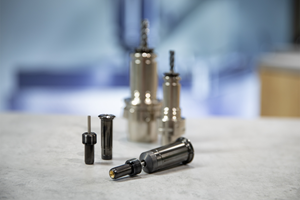Mist Collector Design Fundamentals
Consider design differences when determining what style of mist collector is best for a given application.
Share






Manufacturers use mist collectors on machine tools to provide cleaner air and a better working environment for shopfloor employees. Mist collectors minimize the adverse effects of exposure to metalworking fluids and help shops comply with indoor air quality standards. They also improve in-process part quality by keeping work surfaces clean while reducing maintenance and housekeeping costs.
In general, all mist collectors coalesce tiny mist droplets into larger ones and drain the collected coolant to prevent the filtration system from becoming plugged. (Droplets generated during milling and turning operations range in diameter from 2 to 20 microns for water-soluble coolants and from 0.5 to 10 microns for oil-based coolants.) However, there are differences in the ways that particular mist collector systems remove droplets from an airstream. It’s important to consider these distinctions when determining what design is best-suited for a given application.
One common type removes droplets via electrostatic precipitation. These units work by drawing mist-filled air through an ionizer that gives each droplet either a positive or a negative charge. The charged droplets are then captured by collection cells that use alternating high-voltage and grounded plates to attract the charged droplets. The droplets coalesce on the plates and drain out of the collector. Electrostatic precipitation units are advantageous because there are no filters to replace, they consume a relatively low amount of electricity and they offer high efficiency when fully cleaned. That said, they have fallen out of favor with some due to their frequent, arduous maintenance routines. Their internal components must be kept meticulously clean in order to efficiently charge and capture droplets.
Another design relies primarily on inertial separation to remove droplets from an airstream by diverting the airstream around a collection surface inside the unit. Because the droplets in the airstream have momentum, they continue on their path and impact the surface, ultimately coalescing with other droplets and draining. Inertial separators typically do not have primary filters that need to be changed. However, they require regular maintenance to clean contamination from the components. In addition, inertial separation tends to work better on large droplets than small ones because bigger droplets have more mass and momentum. This increases their chance of impacting the collector surface. Inertial separators have sub-par efficiency when droplets are smaller than 2 microns in diameter.
A third type of mist collector uses fibrous filter media to remove droplets. Droplets adhere to the fibers in the filter media and coalesce with other droplets. When a droplet is sufficiently large, gravity pulls it down the fiber to drain. The challenge using this type of collector is balancing the need for both high efficiency and effective draining. High filtration efficiencies can be achieved using small fibers. However, small fibers typically require resin to hold them together, which prevents coalesced droplets from draining effectively. Therefore, filter media using small fibers can become easily plugged with trapped liquid. Conversely, large fibers have good draining characteristics but can compromise the ability of the media to capture small mist droplets.
Such a circumstance is often mitigated by using layers of fiber media. A pre-filter layer with large fibers, mesh or screens captures and drains large droplets while a second or primary layer with smaller fibers accumulates most of the remaining droplets. An optional third layer uses a HEPA or DOP filter for high-efficiency removal of sub-micron-sized droplets. However, if any of these layers are working poorly, the entire mist collector will be ineffective.
This prompted Donaldson Company, a provider of filtration systems and replacement parts for industrial and engine applications, to develop a more consistent way to realize both high efficiency and effective draining using fiber media. The company’s Synteq XP media is an engineered blend of small and large fibers that uses a proprietary, resin-free bonding system. Heat-fusing the surface of larger binding fibers to surrounding micro-glass fibers provides a stable pore structure that improves unit performance and life because no resin blocks the pores. With no resin to compromise effective draining, the media’s small fibers offer higher filter efficiency. In turn, its larger fibers provide good overall support for the structure while maintaining clear drain channels.
About the author: Karen Geronime is a Torit Product Manager at Donaldson Company, Inc.
Related Content
STLE Opens Registration for 2024 Annual Meeting
The Society of Tribologists and Lubrication Engineers’ 2024 STLE Annual Meeting & Exhibition will take place May 19-23 at the Minneapolis Convention Center in Minneapolis, Minnesota.
Read MoreSTLE Hosts Co-Branded Tribology, Lubrication Events
The 2023 STLE Tribology Frontiers Conference and Tribology & Lubrication for E-Mobility Conference will provide attendees with two opportunities to share and learn the latest tribology and lubrication engineering science.
Read MoreRego-Fix Toolholding System Reduces Coolant Consumption
MQL PG collets are designed for machines using one-channel, internal through-spindle MQL systems.
Read MoreMarubeni Citizen-Cincom Accessories Provide Faster Cycle Times
IMTS 2024: Marubeni Citizen-Cincom is showcasing a range of machining accessories designed to work intuitively with Citizen machines.
Read MoreRead Next
Machine Shop MBA
Making Chips and 91ÊÓƵÍøÕ¾ÎÛ are teaming up for a new podcast series called Machine Shop MBA—designed to help manufacturers measure their success against the industry’s best. Through the lens of the Top Shops benchmarking program, the series explores the KPIs that set high-performing shops apart, from machine utilization and first-pass yield to employee engagement and revenue per employee.
Read MoreLast Chance! 2025 Top Shops Benchmarking Survey Still Open Through April 30
Don’t miss out! 91ÊÓƵÍøÕ¾ÎÛ's Top Shops Benchmarking Survey is still open — but not for long. This is your last chance to a receive free, customized benchmarking report that includes actionable feedback across several shopfloor and business metrics.
Read MoreAMRs Are Moving Into Manufacturing: 4 Considerations for Implementation
AMRs can provide a flexible, easy-to-use automation platform so long as manufacturers choose a suitable task and prepare their facilities.
Read More




















